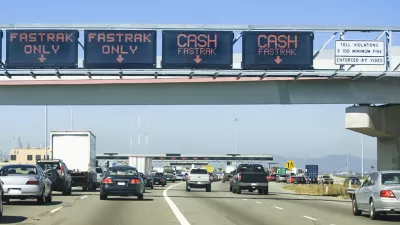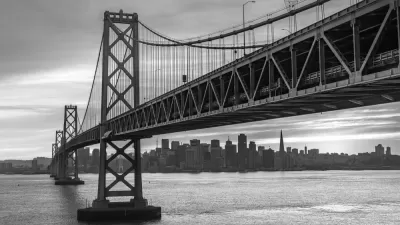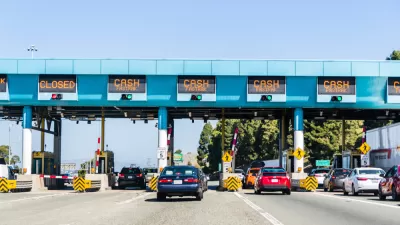A modest toll increase, $3 over six years, took a major step forward with the approval of a key Bay Area Toll Authority committee. With the exception of the Bay Bridge, the round-trip toll on each of the region's seven state-owned bridges is $5.

The July 2010 photo of the toll on the Bay Bridge between San Francisco and Oakland appearing in the San Francisco Chronicle article says it all: motorists crossing the seven, state-owned toll bridges in the Bay Area (does not include Golden Gate Bridge) pay the same toll today that they paid over seven years ago, unlike transit patrons that may see their fares raised annually or biennially.
If approved by a majority of voters in the region's nine counties (unlike transportation sales tax measures which require a two-thirds majority), the $5 toll on six of the bridges would increase by $1 next year, with subsequent $1 hikes in 2022 and 2025, reports Lizzie Johnson on Jan. 10. The $6 peak-hour toll, and $4 off-peak toll, on the Bay Bridge would increase by the same increment at the same intervals.
But to get before voters, the [Bay Area Toll Authority Oversight Committee's] recommendation will need approval from the full Bay Area Toll Authority which usually follows the committee’s lead. A vote is expected Jan. 24.
If the authority gives the measure the go-ahead, the Board of Supervisors in each of the nine affected counties will make the final vote to place it on each county’s ballot for June 5 as Regional Measure 3.
The toll increase would raise about $4.5 billion over 30 years to pay for a wide range of projects, writes Johnson. According to an email by Rebecca Long, manager of government relations for the Metropolitan Transportation Commission, the parent agency of the toll authority, "[w]hen operating funds are included over 25 years, the final mode split is 69% transit, 25% highway (interchange improvements, express lanes and some safety projects), 3% multimodal (Goods movement/Mitigation) & 3% bike/ped."
The three most costly projects are BART expansion cars ($500 million), BART to San Jose phase 2 ($375 million), and Caltrain downtown San Francisco extension, $325 million.
Regional Measure 3 is based on legislation, SB 595 by Sen. Jim Beall (D-San Jose), signed by Gov. Jerry Brown last October. It be the first time that all nine counties would vote to hike tolls. Regional Measure 1 in 1988, which hiked tolls to $1 for all seven bridges, and Regional Measure 2 in 2004, a $1 toll increase, appeared on ballots in seven counties, with Napa and Sonoma not participating. Tolls were also raised legislatively by $1 on three occasions for seismic retrofit purposes.
FULL STORY: Proposal for $9 tolls on Bay Bridge, $8 on other bridges gets big boost

Maui's Vacation Rental Debate Turns Ugly
Verbal attacks, misinformation campaigns and fistfights plague a high-stakes debate to convert thousands of vacation rentals into long-term housing.

Planetizen Federal Action Tracker
A weekly monitor of how Trump’s orders and actions are impacting planners and planning in America.

San Francisco Suspends Traffic Calming Amidst Record Deaths
Citing “a challenging fiscal landscape,” the city will cease the program on the heels of 42 traffic deaths, including 24 pedestrians.

Defunct Pittsburgh Power Plant to Become Residential Tower
A decommissioned steam heat plant will be redeveloped into almost 100 affordable housing units.

Trump Prompts Restructuring of Transportation Research Board in “Unprecedented Overreach”
The TRB has eliminated more than half of its committees including those focused on climate, equity, and cities.

Amtrak Rolls Out New Orleans to Alabama “Mardi Gras” Train
The new service will operate morning and evening departures between Mobile and New Orleans.
Urban Design for Planners 1: Software Tools
This six-course series explores essential urban design concepts using open source software and equips planners with the tools they need to participate fully in the urban design process.
Planning for Universal Design
Learn the tools for implementing Universal Design in planning regulations.
Heyer Gruel & Associates PA
JM Goldson LLC
Custer County Colorado
City of Camden Redevelopment Agency
City of Astoria
Transportation Research & Education Center (TREC) at Portland State University
Jefferson Parish Government
Camden Redevelopment Agency
City of Claremont





























